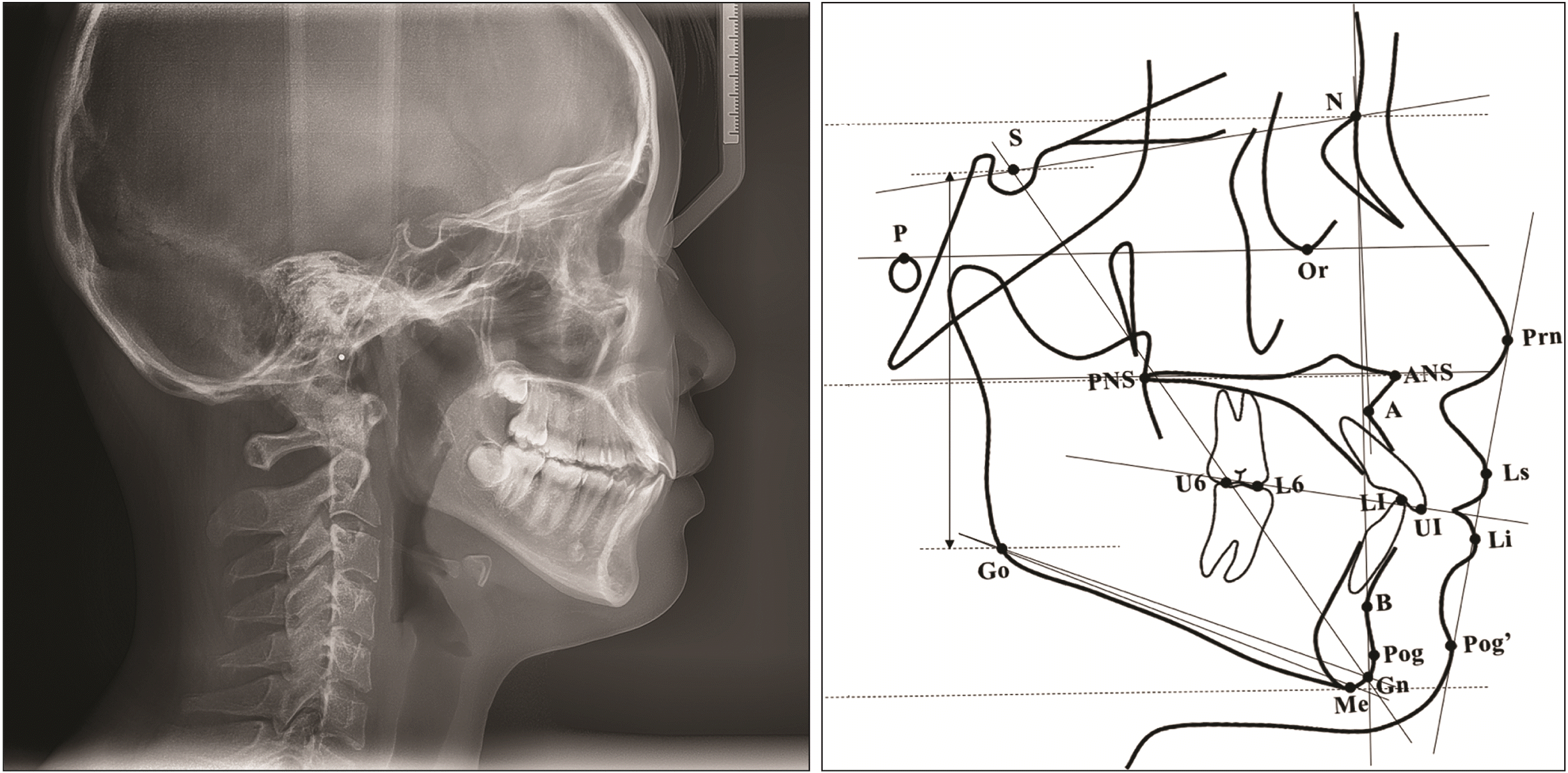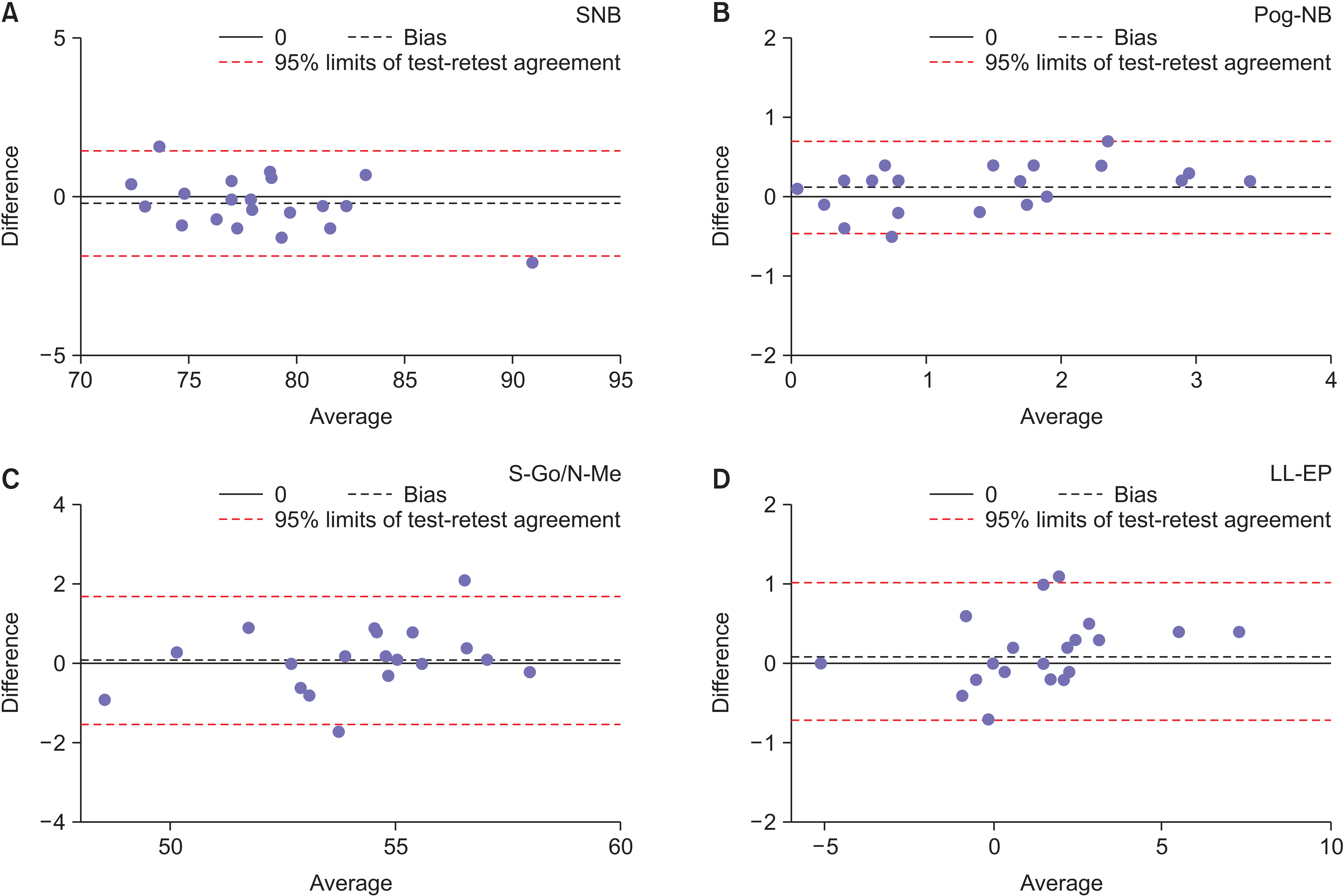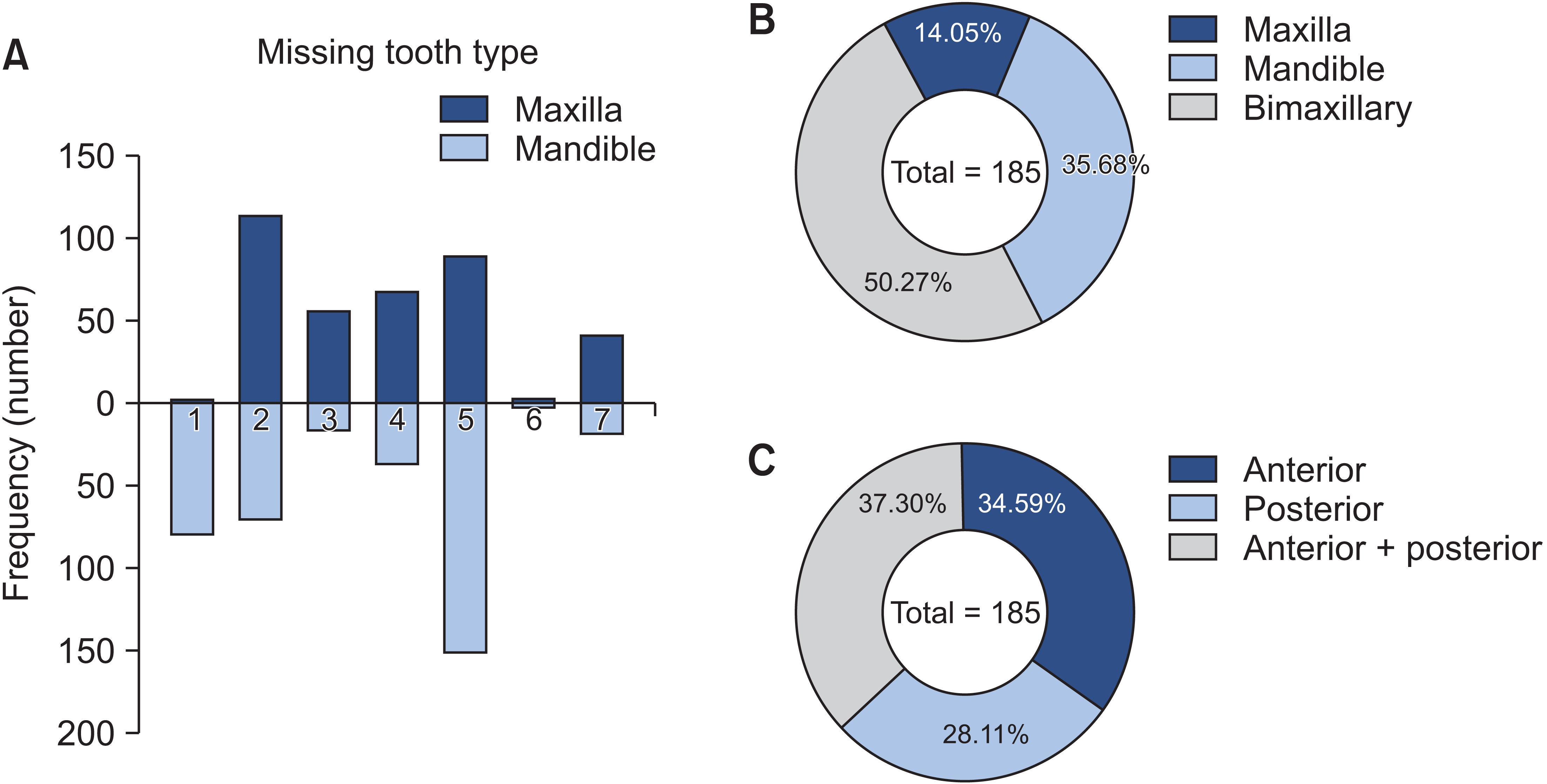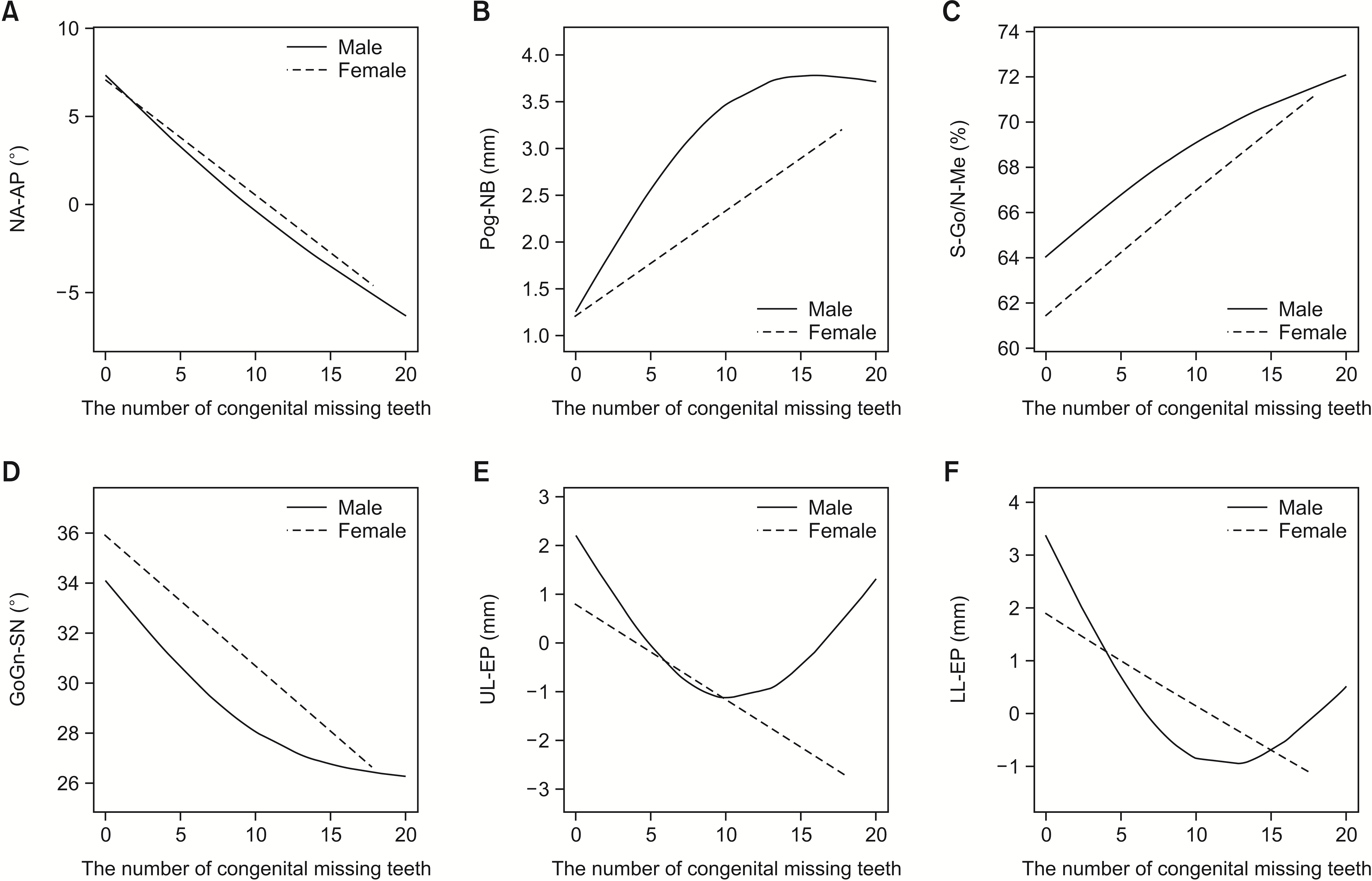INTRODUCTION
Hypodontia, or congenitally missing teeth, is one of the most prevalent developmental disorders characterized by the congenital absence of one or more teeth, excluding the third molar.
1-3 The prevalence of hypodontia varies from 0.3–13.3%,
3,4 depending on sex, ethnicity, geographical regions, and dentition type. Females have been reported to have a slightly higher prevalence than males, with a ratio of 1.37:1, and hypodontia was more common in deciduous dentition than in permanent dentition. Remarkably, the incidence of hypodontia has increased over the last few decades and appears to have a negative psychosocial impact on individuals.
5-8
Hypodontia is classified as nonsyndromic or syndromic. Nonsyndromic hypodontia is an isolated trait that only involves congenitally missing teeth, whereas syndromic hypodontia can be associated with a cleft lip and palate or more than 50 craniofacial syndromes.
2,9 Based on the number of missing teeth, hypodontia can be classified into different severities: mild (one or two missing teeth), moderate (three to five missing teeth), and severe (six or more missing teeth).
10,11
It is generally agreed that hypodontia may occur due to genetic regulation and environmental factors. Several studies have confirmed that various genes, such as
PAX9,
AXIN2,
FGF3,
FGF10, and
BMP4, are associated with tooth agenesis.
6,12,13 Therefore, mutations in these related genes may contribute to hypodontia.
14 However, no consensus has been reached on whether hypodontia is caused by a polygenetic or single gene defect. Environmental factors that can interfere with tooth development, including maternal exposure to alcohol and smoking, thalidomide, and rubella infection during pregnancy, may be related to hypodontia.
4,6,15
Patients with hypodontia have different dental and craniofacial morphological characteristics than people without hypodontia. Although this association has been broadly investigated, the conclusions among different studies were inconsistent due to non-negligible sample heterogeneity.
6,9,16 Several studies confirmed that patients with hypodontia had a reduced facial height, a smaller mandibular plane angle, a tendency to develop a retrognathic maxilla, and a Class III skeletal relationship, resulting in a flatter or more concave profile.
1,17-19 Furthermore, hypodontia severity may be associated with craniofacial morphology alteration.
10,16,20 In contrast, some studies have revealed bimaxillary retrognathism
7,21 and a higher prevalence of Class I skeletal relationship in patients with hypodontia,
22 while others found that hypodontia did not fabricate a significant skeletal distinction.
7,23 Since no consensus has yet been reached in the literature, further research is required to elucidate this issue thoroughly.
This study investigated the association between hypodontia severity and craniofacial morphological characteristics measured by cephalometry. Additionally, it explored the relationship between certain craniofacial features and the increasing number of congenitally missing teeth. The null hypotheses were as follows: 1) there was no difference in the characteristics of craniofacial morphology between individuals with or without hypodontia, and 2) there was no association between hypodontia severity and craniofacial morphology characteristics.
DISCUSSION
Statistical analysis revealed significant differences in several measurements between the control group and the patients with mild, moderate, and severe hypodontia; hence, the null hypothesis was rejected.
This study found that the most frequently congenitally missing teeth were mandibular second premolars, followed by maxillary lateral incisors and mandibular incisors, as reported by several studies.
7,18,26,29 It has been proposed that human dentition tends to be smaller with fewer teeth. The most distal tooth in each tooth type was suggested to be the least genetically stable tooth with the highest potential to be congenitally missing,
6 which could partially explain the results found in this study.
Chan et al.
18 reported that the maxilla was significantly retrognathic in patients with severe hypodontia by revealing a significant reduction in SNA and NA-FH, which partially agrees with the significantly reduced SNA and NA-FH found in the postpubertal group in the current study. In the prepubertal/circumpubertal, and postpubertal groups with varying hypodontia severity, a significantly reduced NA-AP was found, indicating that the maxilla position related to the face was more retrognathic in patients with hypodontia, consistent with the findings of Ben-Bassat and Brin
21 and Ogaard and Krogstad.
27 Notably, in the prepubertal/circumpubertal groups, such differences were not detected when comparing patients with and without hypodontia. ANB exhibited the same tendency, revealing that hypodontia severity plays an essential role in craniofacial morphology. Additionally, it was observed that as the hypodontia severity increased, ANB reduced; therefore, it was concluded that patients with hypodontia tended toward a Class III skeletal relationship.
2,9,10,18,26 Meanwhile, Bassiouny et al.
30 studied a sample of patients with congenitally missing maxillary lateral incisors and proved them to have a significant tendency to develop a Class III skeletal relationship with reduced ANB and Wits. In the present study, chin protrusion, measured by Pog-NB, was significantly increased in postpubertal patients with hypodontia, indicating that patients with hypodontia appeared to have a more prominent chin. This finding is supported by Chan et al.
18 and Lisson and Scholtes,
31 who found that patients with hypodontia generally had a thicker chin button.
Permanent teeth absence has been reported to result in underdevelopment of the maxilla or mandible.
16 Therefore, retrognathism may occur in the maxilla, mandible, or a combination of both, depending on the hypodontia location. Another theory proposed by Ogaard and Krogstad
27 stated that maxillary retrusion occurring in patients with hypodontia was due to anterior rotation of the mandible due to the lack of support from posterior teeth. This theory could also explain the tendency toward a Class III skeletal relationship and chin protrusion discovered in this study.
Regarding vertical relationship measurements, N-Me and ANS-Me were significantly smaller in prepubertal/circumpubertal patients with hypodontia. In contrast, ANS-Me/N-Me was significantly smaller in the postpubertal group, revealing either an absolute decrease or a relative decrease in lower anterior face height, which concurred with the results of previous studies.
7,32,33
Several studies have reported a flatter mandibular plane in patients with hypodontia,
18,20,27,34 which supports the finding of a significantly reduced GoGn-SN in prepubertal/circumpubertal, and postpubertal hypodontia patients. A significantly increased S-Go/N-Me was also observed in these groups, demonstrating a counterclockwise growth rotation, in agreement with Acharya et al.,
10 who found that in severe hypodontia, the total posterior face height increased, the total anterior face height decreased, or both, leading to increased S-Go/N-Me. Conversely, Vucic et al.
1 spotted a decrease in the lower posterior facial height in children with anterior hypodontia, suggesting a tendency to develop hyperdivergent craniofacial patterns.
The presence of sufficient teeth contributes to the vertical development of the alveolar process in both the maxilla and mandible. With the increasing number of absent teeth in patients with hypodontia, the deficiency of vertical development of the alveolar process might occur.
16 Additionally, permanent teeth absence results in a lack of posterior occlusal support,
35 which could lead to anterior mandible rotation. The significantly different vertical relationship measurements in patients with hypodontia found in this study, including a reduced lower anterior face height and a flatter mandibular plane, may be attributed to the deficiency of vertical development and anterior mandible rotation.
Further, UL-EP and LL-EP significantly decreased in postpubertal patients with hypodontia, indicating that they had more retrusive lower lips, in agreement with previous studies.
20,27,30 It has been hypothesized that the difference in soft tissues in patients with hypodontia could be explained by an altered tongue-lip-pressure balance or an adaption of the tongue in the hypodontia region.
7,28 Remarkably, UL-EP in the prepubertal/circumpubertal group with different hypodontia severities significantly decreased; however, such a difference was not discovered in the comparison between the two groups with or without hypodontia, which further emphasized the potential impact of hypodontia severity.
More importantly, sex may play a role in the relationship between hypodontia severity and craniofacial morphological characteristics. Sex differences in masticatory performance and occlusal force have been reported previously, revealing that males usually have greater occlusal force than females,
36,37 mainly attributed to the greater muscular potential of males. In contrast, females might compensate for their low muscle strength with enhanced coordination of other motor and sensory functions.
38,39 Therefore, based on the results of this study, it is speculated that males are more affected by the number of congenitally missing teeth because they are more dependent on occlusal force support. However, above a certain threshold (for example, more than 10 congenitally missing teeth), the influence of absent teeth decreases.
Although most of this study’s results are consistent with those of most previous studies, the association between hypodontia severity and craniofacial morphology was further elaborated in this study. Moreover, this study revealed that sex may play a role in craniofacial morphology in patients with hypodontia.
This study had some limitations. First, the standard deviations of a few measurements were relatively large, which could be attributed to the small sample size of the severe hypodontia group due to the low prevalence of severe hypodontia. However, according to the sample size calculation, 80% power could be achieved based on the current sample size. Second, only Chinese subjects who sought treatment in one center were included, which could have biased the findings. Therefore, the results should be extrapolated to patients with hypodontia of other ethnicities with extreme caution. In addition, the possible late formation of premolars or second molars could introduce bias since participants from 7 years of age were included. Finally, since this was a cross-sectional study, it cannot reflect any cause-and-effect relationship, and further longitudinal studies should be conducted to clarify the exact relationship.




 PDF
PDF Citation
Citation Print
Print







 XML Download
XML Download